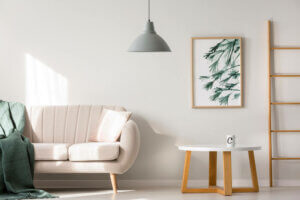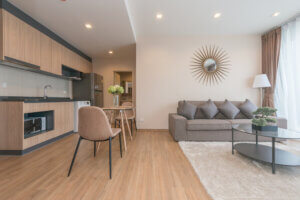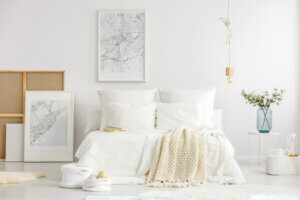How to Achieve Simplicity in Your Home

The home decoration process can cause a wide array of problems – organization, order, and cleaning. However, there are alternatives, such as embracing simplicity as a decorative home concept.
Why not just use the most important decorative objects that add meaning to your room? The art of decoration is increasingly becoming a focus of new ideas and innovation. Only certain elements that contribute to it are highlighted.
When designing the interior of your home, don’t limit yourself to cluttering up every open space you have. Each decorative object needs to have a purpose.
With very little, you can achieve a lot

As we’ve previously mentioned, you don’t need to clutter your space to achieve great interior design. If the room contains fundamental elements for basic and functional decoration, then that’s enough.
For example, how can you decorate a living room without the excessive use of resources? You could use conventional furniture to provide comfort and in turn, simple decoration.
To achieve this objective, use a sofa, central table, bookshelf, and television cabinet. Complement these with other small objects: plants, ornaments, wall pictures, and photographs.
How to achieve simplicity as a decorative concept

One of the most common mistakes in rooms is the lack of relevant decorative elements. What advice should you follow?
- Study the purpose of the decorative elements in your room. Make sure they are useful and functional. Using elements that don’t serve a purpose can cause disorder.
- Each piece of furniture must be arranged a certain way in a particular room for it to achieve its purpose. You need space to walk around as well.
- Remember, it’s useless to decorate a room with many objects. It makes it more difficult to make sense of where everything should be and what purpose things have.
- It’s okay to leave parts of the room empty. For example, don’t clutter your walls with useless objects. Leave space on the wall to highlight its color.
Formal refinement of the bedroom

The bedroom is where the concept of simplicity should be enforced. This is the room where the furniture is arranged with greater functionality.
Keep in mind that your bed will take up the most space, so it will be the focal point. However, in order to achieve simplicity, don’t use too many intense patterns or colors. Neutral tones are best.
Next, you can focus on decorating the rest of the room. Which object will be the most useful? A chair, a nightstand, a lamp, and your wardrobe. You need to abandon the concept of accumulating things in your room.
The most basic resources are where you can find the most sophisticated designs.
What can you do with colors to achieve simplicity?

We suggest that you search for the neutral aesthetics of colors. If you apply strident or intense colors, then you risk derailing your objective of attaining simplicity.
White, gray, green, or black are good choices. The use of a monochromatic system favors the simplistic environment.
The home decoration process can cause a wide array of problems – organization, order, and cleaning. However, there are alternatives, such as embracing simplicity as a decorative home concept.
Why not just use the most important decorative objects that add meaning to your room? The art of decoration is increasingly becoming a focus of new ideas and innovation. Only certain elements that contribute to it are highlighted.
When designing the interior of your home, don’t limit yourself to cluttering up every open space you have. Each decorative object needs to have a purpose.
With very little, you can achieve a lot

As we’ve previously mentioned, you don’t need to clutter your space to achieve great interior design. If the room contains fundamental elements for basic and functional decoration, then that’s enough.
For example, how can you decorate a living room without the excessive use of resources? You could use conventional furniture to provide comfort and in turn, simple decoration.
To achieve this objective, use a sofa, central table, bookshelf, and television cabinet. Complement these with other small objects: plants, ornaments, wall pictures, and photographs.
How to achieve simplicity as a decorative concept

One of the most common mistakes in rooms is the lack of relevant decorative elements. What advice should you follow?
- Study the purpose of the decorative elements in your room. Make sure they are useful and functional. Using elements that don’t serve a purpose can cause disorder.
- Each piece of furniture must be arranged a certain way in a particular room for it to achieve its purpose. You need space to walk around as well.
- Remember, it’s useless to decorate a room with many objects. It makes it more difficult to make sense of where everything should be and what purpose things have.
- It’s okay to leave parts of the room empty. For example, don’t clutter your walls with useless objects. Leave space on the wall to highlight its color.
Formal refinement of the bedroom

The bedroom is where the concept of simplicity should be enforced. This is the room where the furniture is arranged with greater functionality.
Keep in mind that your bed will take up the most space, so it will be the focal point. However, in order to achieve simplicity, don’t use too many intense patterns or colors. Neutral tones are best.
Next, you can focus on decorating the rest of the room. Which object will be the most useful? A chair, a nightstand, a lamp, and your wardrobe. You need to abandon the concept of accumulating things in your room.
The most basic resources are where you can find the most sophisticated designs.
What can you do with colors to achieve simplicity?

We suggest that you search for the neutral aesthetics of colors. If you apply strident or intense colors, then you risk derailing your objective of attaining simplicity.
White, gray, green, or black are good choices. The use of a monochromatic system favors the simplistic environment.
All cited sources were thoroughly reviewed by our team to ensure their quality, reliability, currency, and validity. The bibliography of this article was considered reliable and of academic or scientific accuracy.
- Walton, Stewart: Guía completa de decoración: 1000 ideas de diseño para el hogar, Blume, 1997.







